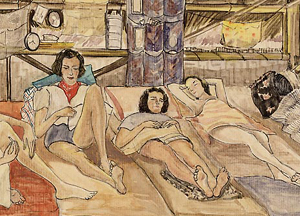Drawings from the camps in the occupied Dutch East Indies (1942-1945) > About the collection
The largest collection of drawings made in the Japanese internment camps – almost 4,000 of them – can be found at Museon in The Hague. Moreover, Museon is in the possession of a varied collection of relics from the camps, such as household items, documents, tools, music instruments the camp inmates made themselves, etc. NIOD’s 250 linear meters of archives relating to the occupation of the Dutch East Indies include more than a thousand additional drawings.

These drawing are of major importance because there are hardly any photographs illustrating the Japanese presence in the Dutch East Indies. The available photographs of the camps were made a couple of months after the capitulation of Japan and, therefore, they do not give a true image of the living circumstances in the camps during the Japanese occupation. The impressions the internees reproduced in their drawings, however, do give a good picture of life in the camps. The drawings have varied subjects. Among them, of course, many views of the camp and of the interior of the camp buildings. Food too – or rather the lack of it – is an often recurrent theme. All sorts of labour, some of it forced, are featured in many drawings. Sickness and death are the subjects of other drawing, but these themes appear much less frequently than for instance the activities the camp inmates undertook to pass the time, such as making music, playing games, reading, performing in cabaret shows. Forming an entirely different category are the nostalgic drawings with subject like snowy landscapes, polders with Dutch windmills or a surprising drawing of two penguins.
Most drawings were made with charcoal, pencils, water colours and colouring agents that were available locally. Paper was scarce; often one sheet was used for more than one drawing; sometimes drawings were made on the printed pages of a book. The collection includes work by well-known artists like Johan Gabriëlse, Charles Burki, Jan Kickhefer, Theo Goevriend or Frida Holleman, but there are also drawings made by men and women who had not had a drawing pencil in their hand since they were children.
These drawings have travelled many thousands of miles: from the Far East, to a forgotten box in the attic of a Dutch house, to Museon or NIOD. The person who played an important role in bringing together drawings and camp objects was Mr. P.M. Adriaanse, who put together a travelling exhibition of drawings in 1975. The drawings that had been displayed on the occasion remained together and were entrusted to Museon. Since then, the number of drawings in the hands of Museon has increased steadily. Unfortunately, one theme has been almost completely missing from them all these years: the life of the people who were not interred.
In cooperation with NIOD, Museon developed two educational programs called ‘Interned by Japan’ on the basis of the camp drawings, one for highest forms of primary schools, the other for the last two years of secondary schools.
